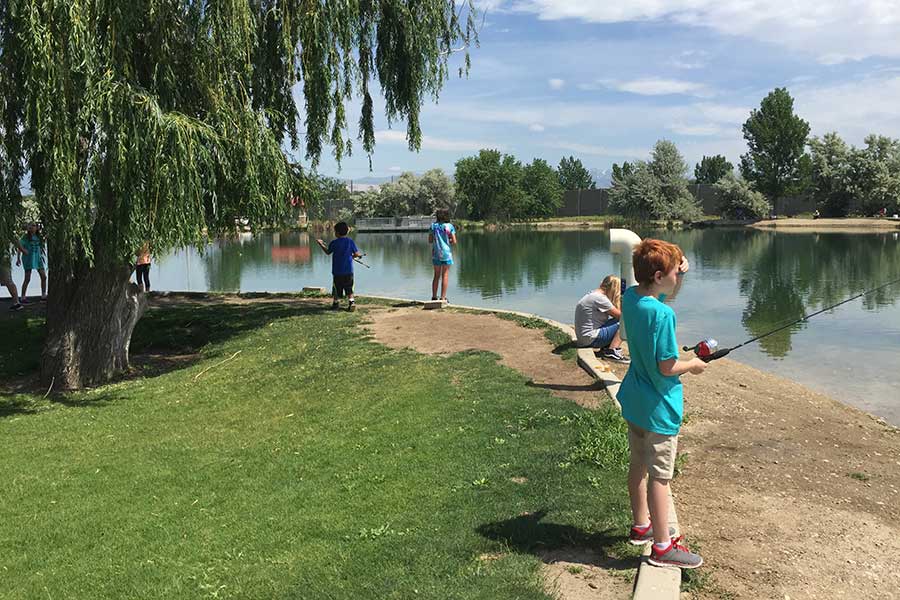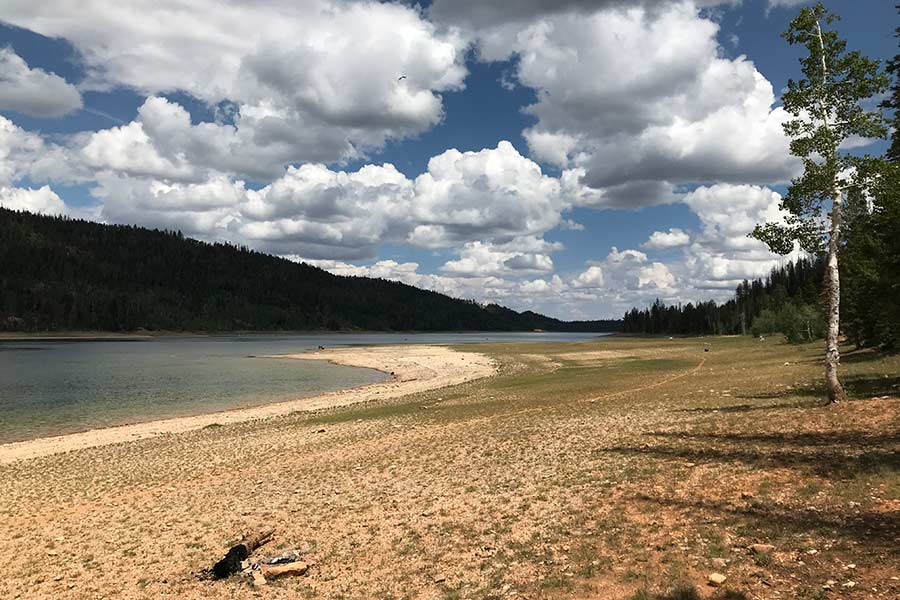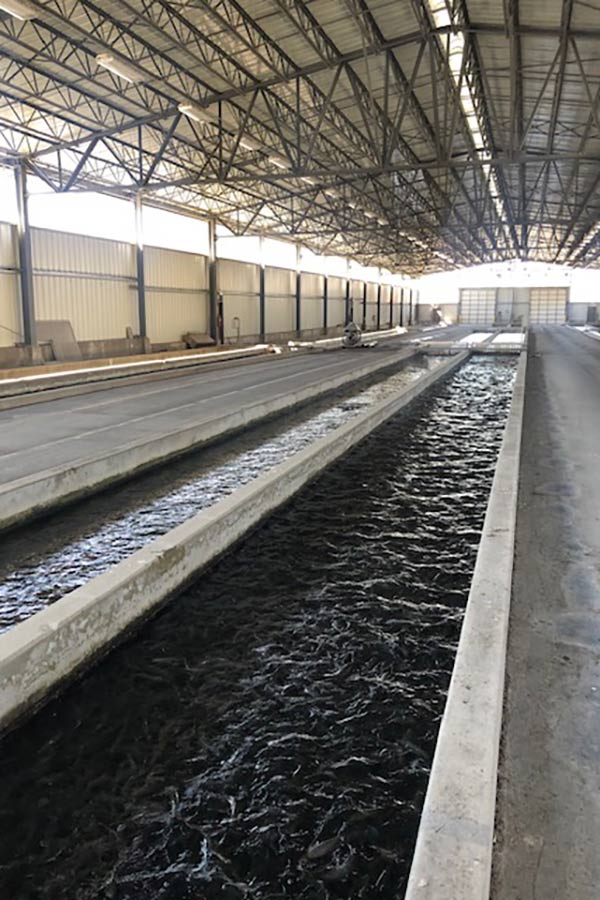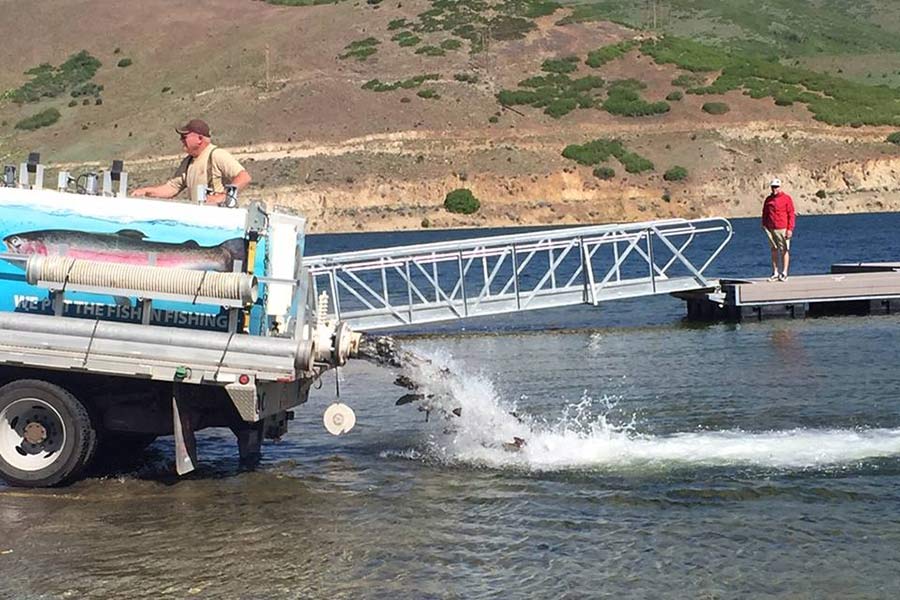How Utah's fish hatcheries adapt to drought
Living in an arid region influences DWR hatchery fish production and stocking efforts
Roger Mellenthin
DWR Fish Culture Coordinator
Have you seen the impacts of drought at your favorite fishing spot? Drought impacts fish by reducing the amount of water available in lakes, reservoirs and streams throughout the state. These are primary habitats for Utah's fish, and having less water affects fish in multiple ways.
Drought also significantly impacts our fish hatcheries, which rely upon groundwater for filling and refreshing the water in our tanks, raceways and ponds. We also must plan years in advance to decide how many eggs to fertilize and determine which species of fish to grow, all of which can be impacted by drought conditions at hatcheries. And we continually adapt stocking strategies for specific Utah waterbodies depending on their current and anticipated drought conditions.
It's part science-based strategy, part game of chance: Going into each year, we never know if we'll have enough water to raise fish at the hatcheries, and if the lakes will have enough water to stock fish into them. So, as much as possible, we prepare for any and all of those challenges, from the eggs we grow at a hatchery to the fish you catch on your line.
That's a lot of fish
Did you know that the roots of the DWR hatchery program go back as far as 1871? That's when the first hatchery-raised fish were released in the state. And in 1882, the Utah legislature created the position for a territorial fish commissioner and dedicated funds for building a fish hatchery in Salt Lake County.
Now, the DWR's 13 hatcheries stock almost 10 million fish — ranging in size from tiny fingerlings to 12-inch rainbow trout — at more than 1,000 Utah waterbodies every year. Our primary goal is to create a fun and successful fishing experience for Utah anglers.
How drought fluctuations impact hatchery production
Most Utah hatcheries only use groundwater — drawn from springs or wells — for the hatchery water supply. This reduces the risk of aquatic invasive species, disease and other contamination.
Each hatchery in the state serves a unique purpose. Some raise a few specific warmwater or coldwater fish species best suited to the region, and some specialize in producing fertilized fish eggs. Depending on the location and the hatchery's objectives, ongoing drought has impacted our hatcheries differently:
- Some hatcheries can recycle old water, and recent droughts don't impact the cubic feet per second flows as much.
- Hatcheries like Whiterocks, Mammoth Creek and Fountain Green must collect new water each year after runoff, and they will experience significant water level drop as a drought-impacted season goes on.
- Loa's spring-fed hatchery has the largest consistent water source of all of Utah's hatcheries, and the water temperature at Loa is perfect for raising trout. (Note: The Loa Hatchery needs substantial renovation and is not currently in operation.)
- At the Midway hatchery, water availability has dropped continually over the past seven years. It takes 6 cfs to run that hatchery adequately, and flows have dropped as low as 3 cfs. We are cleaning the wells to try to recover some flow, but we are having to draw down further to get the same flows we expected when the hatchery was built.
- Fountain Green is our largest producing hatchery by pounds of fish, yet the water source is unreliable in drought years. The Fountain Green hatchery can see flow fluctuations from 2.1 to 19.8 cfs. It takes at least 5 cfs to run this hatchery productively.
To put this in a planning context, all of our hatcheries are currently stretching their limits to make fish stocking quotas. Losing hatchery capacity to drought makes meeting the demand even more difficult. For example, in ideal conditions, it takes about 14 months to raise a catchable-size trout. With ongoing drought, it is hard to know if we will have enough water for the fish in our hatchery 14 months in advance if water flows are not consistent.
We'll talk about strategies and technologies we're using to compensate for inconsistent water supply in the conclusion of this post.
How drought at Utah waterbodies influences stocking priorities
Low water in reservoirs and lakes impacts where fish can be stocked, and what time of year they are stocked.
When a hatchery is loaded with fish and the water level drops at the hatchery, we need to stock earlier than anticipated to keep fish alive. This can have a ripple effect. If it's too early in the season, the lake might not have enough food available for a large number of introduced fish, or the water quality in the receiving water may not be the best. Also, the younger-than-ideal fish may be too small to escape predators.
And if we wait too long to stock fish in drought-impacted waterbodies, the water is often too warm for fish to thrive. Basically, warm water holds less oxygen than cold water. Reduced oxygen, combined with high temperatures, means low fish survival for both existing fish and stocked fish.
Any of these factors can lead to a reduction in the number of fish available to anglers.
While we're still producing the same number of fish each year at our hatcheries, we've adjusted our stocking strategies throughout the state to anticipate drought impacts. Our goal is to get the most healthy fish out to the most viable waterbodies in the following ways:
- We stock fewer fish in shallow reservoirs — such as Navajo Lake — that are particularly hard hit by the combined conditions of low water and hot water temperatures during drought.
- More fish are stocked in deep reservoirs like Fish Lake, which can hold more food resources and oxygen.
- We take into consideration the fish species that are stocked at drought-impacted waterbodies. For example, instead of exclusively stocking coldwater trout species, more warmwater species that aren't as negatively impacted by high water temperatures are stocked into some waters.
- Adjusting the timing of when fish are stocked. For example, instead of stocking fish in the spring right before the hot summer may impact water levels and water temperatures, some fish are stocked in the fall so they can be caught during the autumn and winter months.
Planning ahead for drought recovery
Optimistically, hatchery fish will be necessary to help some decimated fisheries recover after the drought ends. Because we have no way of predicting beforehand when the drought will be over — combined with the long lead-time needed to raise fish — we have been reluctant to cut back production.

We've adapted and innovated in the face of drought to continue providing great fishing for Utah anglers.
Unfortunately, that means we have had to stock many fish early and not get the optimal return from them during drought years. With these lessons learned, we have been adapting our technologies and strategies to anticipate dramatic shifts in water supply.
At the hatcheries, there are a few technologies that help us cope with low water. Oxygen is the biggest limiting factor in fish production. We have invested in equipment that helps hatcheries keep the oxygen saturation high enough to keep fish healthy. Some of the technologies we use are:
- Oxygen injection units, oxygen cones, backup oxygen stones and aerators that allow us to raise more fish in less water.
- Low water flows make waste management difficult, so our new raceways are built with baffles to increase the velocity at the bottom of the raceways, and we create low-flow zones at the ends to allow waste to settle into an area where it can be easily removed.
- We use on-site water recycling systems to reclaim and clean water for recirculation.
- The ultimate tool for coping with low water is a recirculating aquaculture system. RAS systems filter out waste and remove carbon dioxide, ammonia, nitrite and nitrates. Using these systems, we can reduce the amount of water we need by 90%! The DWR has a few RAS systems in use at the Fountain Green, Springville and Logan hatcheries.
The drawback is that these systems are expensive to build and labor intensive to run. Because we are so reliant on specialized equipment to maintain the water quality at our hatcheries, there are more risks if that equipment breaks down. We rely on our terrific, skilled aquatics employees who continually run, maintain and repair the equipment. The cost and upkeep of quickly-deployable backup equipment is also an ongoing challenge.
Keeping our production levels steady means that regardless of good water years or drought, we are ready and able to stock healthy fish effectively. Hopefully, this means that Utah's anglers — even in tough drought years — have the opportunity to experience the thrill of getting a fish on the line.


















